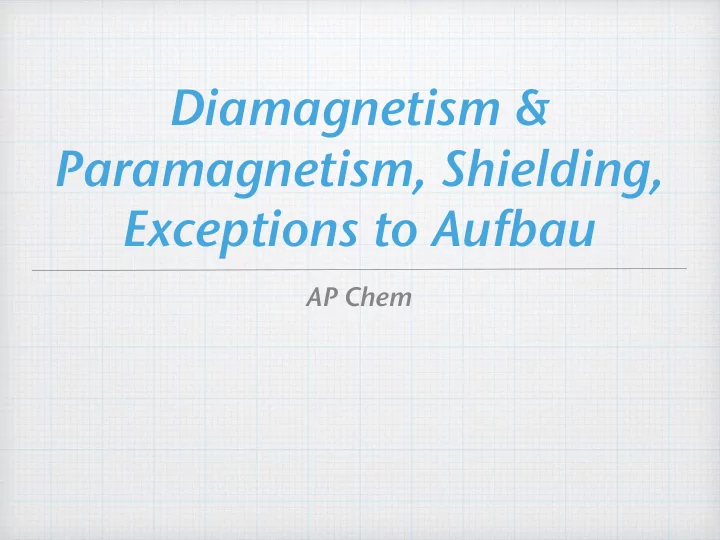

Diamagnetism & Paramagnetism, Shielding, Exceptions to Aufbau AP Chem
Paramagnetism Having 1 or more unpaired electrons Spin of electrons generates magnetic field Substance attracted to magnetic field Observe an increase in apparent mass in a magnetic field Element with an odd # of electrons must be paramagnetic Element with an even # of electrons depends on electron configuration (i.e. Hund’s Rule) Transition metal ions (lose 4s electrons first—Ch. 8) Zn 2+ : [Ar]3d 10 : 0 unpaired electrons Cu 2+ : [Ar]3d 9 : 1 unpaired electron Cr 3+ : [Ar]3d 3 : 3 unpaired electrons Mn 2+ : [Ar]3d 5 : 5 unpaired electrons Fe 3+ : [Ar]3d 5 : 5 unpaired electrons
Diatomic O 2 Molecular Orbital Theory (out of scope) O 2 is paramagnetic Attracted to magnetic field
Ferromagnetism In paramagnetic material, crystal domains can become aligned with external magnetic field Magnetization can be made permanent by heating material above T c , the Curie Temperature, in external field then cooling Magnetization lost upon reheating or through vibrational shock
Diamagnetism Having no unpaired electrons Magnetic fields of electrons cancel out, slightly repelled by a magnetic field Observe a decrease in apparent mass in a magnetic field Atoms at the end of their block
Shielding Why do higher n values have higher energy? Why are s, p, d, etc. split in many-electron atoms? 1s is closer to nucleus than 2s, higher energy levels. 1s electrons shield higher level electron from nucleus, so 2s experiences less coulombic (electrostatic) attraction less attraction ⇒ easier to remove, so higher in energy 2s electrons have significant density near nucleus, shield 2p electrons from full nuclear charge Although 2p closer, on average, to nucleus, it experiences less coulombic attraction, again higher energy
Exceptions to the Aufbau Order Cr: expect to be 4s 2 3d 4 : instead observe 4s 1 3d 5 : As 3d electrons are added, they shield 4s 3d levels slightly lower energy relative to 4s 3d experiences stronger coulombic attraction to nucleus Unpaired, so no e – -e – repulsion to overcome Cu: expect to be 4s 2 3d 9 : but observe 4s 1 3d 10 : As with Cr, shielding makes 3d orbitals lower energy relative to 4s, so more stable
Other Exceptions Many exceptions as energy levels get close together, electrons move more easily between orbitals Need to understand & explain, but not memorize
Recommend
More recommend